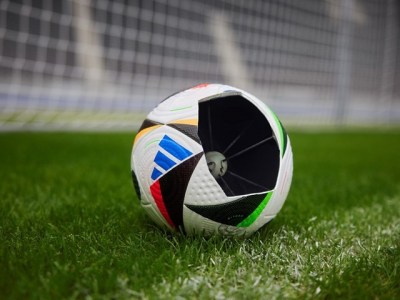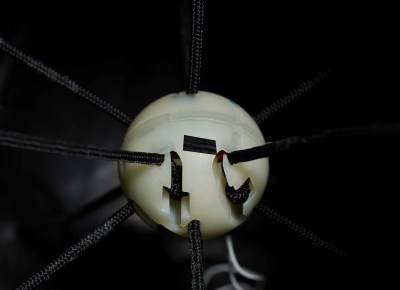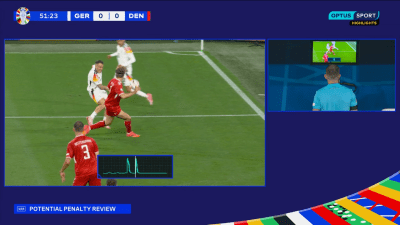
The good old fashioned game of football used to be a simple affair. Two teams of eleven, plus a few subs, who were all wrangled by a referee and a couple of helpful linesmen. Long ago, these disparate groups lived together in harmony. Then, everything changed when VAR attacked.
Suddenly, technology was being used to adjudicate all kinds of decisions, and fans were cheering or in uproar depending on how the hammer fell. That’s only become more prevalent in recent times, with smart balls the latest controversial addition to the world game. With their starring role in the Euro 2024 championship more than evident, let’s take a look at what’s going on with this new generation of intelligent footballs.
The Balls Are Connected

Adidas has been a pioneer of so-called “connected ball” technology. This involves fitting match balls with sensors which can track the motion of the ball in space. The aim is to be able to track the instant of player contact with the ball, for investigating matters like calls of handball and offside. The Germany first debuted the technology at the 2022 World Cup, and it showed up at the 2023 Women’s World Cup and the UEFA Euro 2024 championship, too.
According to Adidas, an inertial measurement unit is suspended in the middle of the ball. This is done with a delicate structure that holds the IMU stably in place without impacting the performance of the ball from the player’s perspective. Powering the TDK ICM-20649 IMU is a small battery that can be recharged using an induction system. The IMU runs at a rate of 500 Hz, allowing hits to the ball to be measured down to tiny fractions of a second. The ball also features a DW1000 ultra-wideband radio system for position tracking, developed by Kinexion.

No more must match officials rely on their own perception, or even blurry video frames, to determine if a player touched the ball. Now, they can get a graphical readout showing acceleration spikes when a players foot, hand, or other body part impinges on the motion of the ball. This can then be used by the on-field referee and the video assistant referee to determine the right call more accurately. The idea is that this data removes a lot of the confusion from the refereeing process, giving officials exacting data on when a player may have touched the ball and when. No more wondering if this ball came close, or if that ball ricocheted based on a rough camera angle. What really happened is now being measured, and the data is all there for the officials to see, clear as day. What could be better, right?
Case In Point

The UEFA Euro 2024 championship was the latest battleground to showcase this technology. As the national teams of Europe went in to play critical matches, players and fans alike knew that this technology would be on hand to ensure the fairest playing field yet. You might think that it would leave everyone feeling happier about how their favored team got treated, but as always, humans don’t react so predictably when emotions are hot and national pride is on the line.
The match between Germany and Denmark was the perfect example of how technology could sway a game, one way or the other. The Video Assistant Referee killed Denmark’s first goal with a ruling from the Semi-Automated Offside Technology system, and the ball technology would soon curse the Danes, too. As Germany’s David Raum crossed the ball, it ever so slightly clipped the hand of Danish player Joachim Andersen. In the past, this might have gone unnoticed, or at the least unpunished. But in today’s high-tech world, there was data to reveal the crime in explicit detail.
As the video replays showed the footage, we were treated to a graph indicating the spike picked up by the ball’s sensors just as it clipped Andersen’s hand in the video. The referee thus granted a penalty for the handball, which has duly slotted home by German striker Kai Havertz. Germany would go on to win the match 2-0, with midfielder Jamal Musiala scoring the follow-up.
The incident inflamed fans and pundits alike, with the aftermath particularly fiery on ITV. “If he didn’t pay that, if he did pay that, we’d be saying, okay, he saw it that way,” said football manager Ange Postecoglou, noting that the technology was creating frustration in a way that traditional referring decisions did not. Meanwhile, others noted that the technology is, to a degree, now in charge. “[Referee] Michael Oliver cannot go to that monitor and say I refuse to take that recommendation,” said VAR pundit Christina Unkel. “This has been issued by FIFA as what he needs to take for consistency across the world.”
Fundamentally, smart ball technology is not so different from other video assist technologies currently being used in football. These tools are flooding in thick and fast for good reason. They are being introduced to reduce variability in refereeing decisions, and ultimately, to supposedly improve the quality of the sport.
Sadly, though, smart balls seem to be generating much the same frustration as VAR has done so in the past. It seems when a referee is solely at fault for a decision, the fans can let it go. However, when a smart ball or a video referee disallows a goal because of a matter of some inches or millimeters, there’s an uproar so predictable that you can set your watch to it.
Given the huge investment and the institutional backing, don’t expect these technologies to go away any time soon. Similarly, expect fan outrage to blossom most every time they are they used. For now, smart balls and VAR have the backing they need to stay on, so you’d best get used to them for now.
















The way to end the controversy would be to eliminate referees entirely. Players must abide by the rules of the sensors, the technology, and the programming. Much like a video game. If the PlayStation says Mario didn’t grab the coin, well then he didn’t! You can’t argue with the console. Blame it on a short in the controller!
Rage kicking the futbol…
If Mario is on a PlayStation you have a lawsuit on your hands.
Soon we’ll be able to replace the players. And the spectators. We’ll be able to just simulate the game.
Then we’ll have perfect games.
Then the rules need to be adapted to take into account the stricter enforcement. Handball should only been enforced if it was on purpose and significant. A sensor would not be able judge this properly.
The job of the referee is to look at the context too and determine the level of punishment. Since neural network would not be able to explain such a decision you need a human or you need a very clearly defined and simple algorithm that takes hundreds of parameters into account, which is an oxymoron.
The accelerometers can determine if the ball was significantly deflected. So you could (theoretically) set a threshold for what that number is, and let off faint brushes.
How are digital sensors going to judge pussy soccer players flopping?
It’s all about the performance.
Bad calls are part of the games, but have computers grade the refs.
It only took 10 years to get ‘what’s his name’ out of baseball.
Can we fit IMU’s to the players so that we can detect what really happened when they go down like a sack of sh…. and roll round on the floor as if they’ve been shot?
Men’s football has become a joke. It lacks of sportsmanship and is just opportunistic behavior to try to get an advantage, and they are not even trying to hide it. This kind of behavior should be punished and bring back football to be a sport again.
I thought that this year’s Euros were mostly much better for that than previous tournaments. I took particular delight in watching referees ignore Ronaldo rolling around like he’d just been shot every time an opponent came near him.
I thought that the referees did a much better job overall, a few decisions notwithstanding.
I completely agree. A referee might miss it, but when a video clearly shows a player has cheated they’re not punished. They’re not even ashamed that they did it.
Women’s footbal does seem to suffer from this (yet). The worst thing is that kids’ football does. “If the professionals cheat, why shouldn’t I?”
Yes, especially when parents sign their kid into a league that is for kids 2 years younger, and when coaches seem to encourage their players pushing other players around.
The best kids soccer coach I had taught me that tripping was against the rules, unless you do it with the ball.
Then it’s completely legal, but you have to chase the ball after.
If you do it wrong, you’ve just given away the ball.
Practice ‘tripping balls’ is needed.
We did the drill, every practice.
Pushing is similar. It’s normal for two players chasing the ball to want the same space. Who was pushing? The guy who ‘fell’?
And it could generated automated nominations for Best Actor on the Field of Play.
I stopped watching football around 4 world cups ago when the standard of play and sportsmanship degraded quite significantly. I now watch Rugby instead. I also used to watch F1 but the FIA stuffed that up too.
VAR is very badly implemented in football, to the point where sometimes the referee still takes the wrong decision despite clear video evidence.
Can you clarify that? If video and stuff shows one thing and the ref makes a wrong decision, doesn’t that mean the ref (not the technology) is at fault?
BBC had an article on it a few months back. I can’t remember the details but it’s about who makes the call to use VAR, how it’s communicated etc.
In hockey (that is field hockey to leftpondians) it’s the team that can ask for the VAR. If the VAR agrees with their claim (like: this was not shoot, so should not be a penalty corner against us), they get to keep the ability to call in the VAR. If it is denied, they can no longer ask for VAR for the rest of the game.
In volley games the the team coach or team captain can ask for the VAR, I think at most three times in a game. But I have seen volley players calling out to the referee when they knew they had committed a fault and the referee was not assigning the point to the other team. More likely to happen if the team has a good advantage, mind you.
I think the problem is that people always think the past was better. It was not. There was plenty of discussion about questionable offside decisions, especially because people at home watching TV could see it a lot better then the referees could, since TV people would go back, pause at the right frame, draw lines etc., which referees could not do.
The offside rule is a very precise rule. If there should be some tolerance or so, maybe the rule should change. Having a precise rule but asking for an imprecise enforcement of the rule opens the gate for injustice. Who decides when to be strict and less strict?
I like the offside rule of ice hockey a lot better. There is way less to argue, the relevant line is physical and everything is a lot more clear. It probably does not work 1:1 in football, but anyway. The problem is, the rule is very precisely defined but hard to enforce precisely. I don’t think they are going to change the rule, so the only way to improve is on the enforcement side.
Ice hockey has offsides?
I didn’t know.
But I don’t watch it…
“The offside rule is a very precise rule.”
Hah, you’ve exposed yourself as a fake. I have it on very good authority that nobody understands the offside rule.
:P
“Hegel is arguing that reality is merely an a priori adjunct of non-naturalistic ethics, Kant via the categorical imperative is holding that ontologically, it exists only in the imagination and Marx is claiming it was offside”
Who cares about football anyway? Its not about sport, its about big money (for players, the UEFA, the medias, the advertisers, …). Don’t we have much more important and urgent things to get right???
That money only exists because so many people care about it.
Can they invent a sensor to track money laundering?
FWIW: Video unavailable
The uploader has not made this video available in your country
Anyone else getting that?
Yep
No idea what country it is available in I tried 4 different ones.
It worked just fine for me in Outer Baldonia.
Doesn’t work for me in Germany.
Nor me in UK
Getting some Death Wish 5 vibes.
Looks like Soccer to me ;) .
Neat tech anyway… Whether the way of the future or not.
Probably to eliminate all bad calls, we should just give the players joysticks and play on-line. :D . Eliminate all bad sportsmanship and bad calls. People can stay in there cells, err homes and watch. Let the game AI make the final calls… Ah life in the future.
You reminded me of the episode where George Jetson and Mr. Spacely went to a robot (American style) football game…
yep, soccer it is.
If the ball were really smart it would run away when people tired to kick it.
The Tech is Sound and really well engineered. Don’t ask how I know. ;)
Is there an easter egg for penalties?
Having watched nearly every game of the Euros, I disagree with the premise of the article. Smart ball technology definitely made the Euros better. Handball is handball, and should be penalized. The fact that it might have been missed before is the age-old problem of referees being human, not a problem because we caught it now.
As someone who remembers the pain of a referee and lineman somehow missing the “Hand of God” despite thousands of fans screaming “Handball!” during a World Cup semi-final, I have no problem with technology helping them get this right. In case you’re thinking that the same decision would be unthinkable today, I’ll remind you that Lionel Messi has also successfully claimed a “Hand of God” goal in recent years. Cheating is cheating, and any technology that helps prevent that should be embraced. The sportsmanship that prevailed in history when many teams were amateur affairs has been replaced by the greed for endorsement deals for winning.
The same technology helped me accept the on-side decision of the final trophy-winning goal, despite every fiber of my being wishing it were off-side. I’m not a fan of the current offside rules which eliminate too many goals for my liking – I’d quite like to see Arsene Wenger’s proposal trialed, where a player is onside until his entire body is offside. I think that it would lead to more exciting play since sitting back and defending would be so much more difficult. The technology did a good job of helping the referees enforce the current rules with some consistency though.
Could it be better? Probably. At a 500Hz sampling rate, there is a 2ms error bound for the timing of an impact, and a 40MPH ball can travel 1.41″ between samples. When someone is given offside by a toe, that potential time discrepancy might matter! The technology will improve though, and consistency with it.
Agreed, on all points.
“Handball is handball, and should be penalized”
I disagree. Context matters.
One player was offside by his “private parts”.
The only time that size really mattered for a footballer.
‘Having watched nearly every game of the Euros’
You almost saw a goal! (Homer)
That last video is geo-restricted.
Inductive charging of the IMU puck centred in space within the ball? Do we know whether they deflate the balls before charging?
You can see a wire coming off it in the close up photo, so maybe the charging coil is taped to the inside of the ball?
Inductive charging of an IMU puck in a ball typically doesn’t require deflating the ball, as the technology can work through the ball’s surface. However, if you’re encountering issues or need a specific solution, you might consider checking with the manufacturer or exploring designs that ensure effective charging without deflation.
Sports fans will always find something to complain about, as sure as water is wet. With technology calling more of the shots, maybe there will at least be fewer threats of violence aimed at the refs.
smart and football in the same sentence. Must be a joke…
If you start measuring something then it becomes unfun.
i started reading about the timing rules for soccer and it is really eye opening, at least for me coming from a basketball tradition. as i understand it, even the mechanical clock comes second to the referee. the referee can do things like overlook a penalty because it’s to the advantage of the opposing team, and then assess the penalty after a delay if that advantage doesn’t pan out! and they can extend play past the end of time for all number of reasons, and with arbitrary power (the ref is the arbiter of time, not the clock). the referee is really king in soccer.
coming from where i come from, i am biased and i think the soccer refereeing situation is untenable. but maybe people like it that way. it’s a sport. it has to be fun. it doesn’t need to approach a platonic ideal. i only watch women’s NCAA basketball and i can’t stand NBA. in the NBA, the players are too big, and too talented, and know eachother too well. it’s a different game. my point is, it’s very hard to know what makes a good game to watch so i would be careful to judge from the outside.
Futbol???? Ohhh you mean soccer with anger issues.
I would rather watch football, it’s more exciting.. besides Travis Kelce is dating Taylor Swift.
(Snort!)
The good old fashioned game of football used to be a simple affair. Two teams of eleven, plus a few subs, who were all wrangled by a referee and a couple of helpful linesmen, and at the end, the Germans always win.